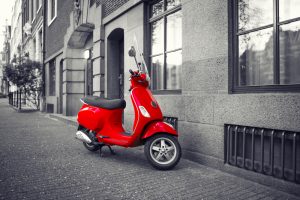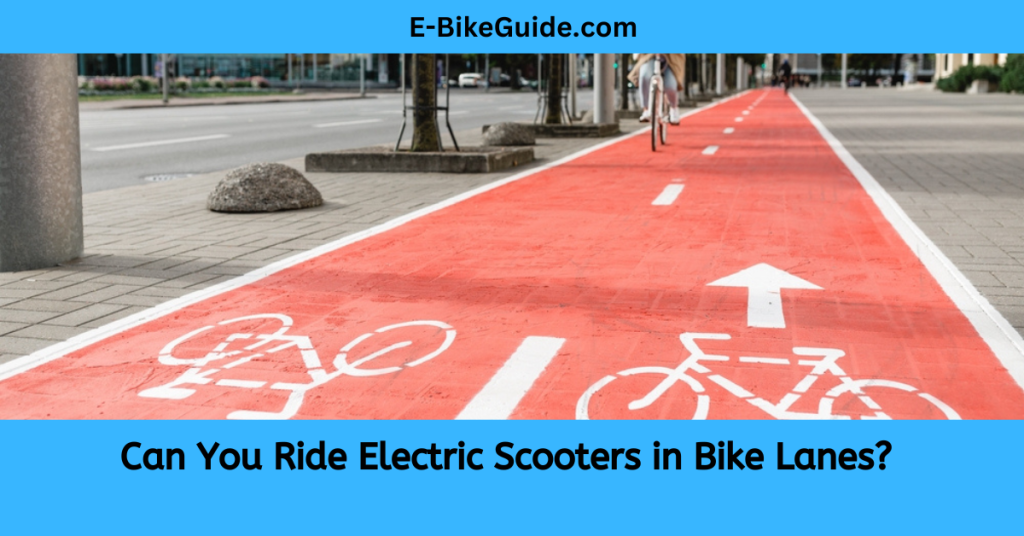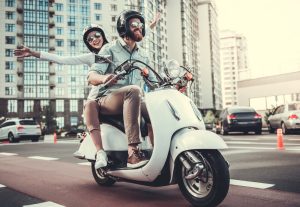What is an Electric scooter?
An electric scooter has two wheels, a deck, which functions as a platform, and handlebars for movement. The inclusion of a battery, large electronic tires, as well as an electric motor, set them apart from non-motorized scooters. Despite the fact that the majority of scooters are made to be ridden standing up on the deck, some can be changed with additions to become seated electric scooters. Scooter sharing has raised public awareness of micro-mobility and fueled the expansion of the personal market, which has resulted in a huge spike in the desire for scooters recently. Due to the market’s fast growth, hundreds of different electric scooter models have been imported by a wide range of different companies.
Types of electrical scooters

- Adult Electric Scooters – The most popular kind of electric scooter on the market is for adults. They differ from electric scooters designed for children because of their higher weight capacity, which is often around 100 kg, stronger motors, bigger batteries, bigger decks, and higher stems. Adult electric scooters frequently cost at least $300, whereas children’s electric scooters are frequently available for less than $200.
- Children’s Electric Scooters – Electric scooters made for children or teenagers are often more affordable, lighter, and smaller than those made for adults. They frequently have weak motors, poor energy density lead-acid batteries, and less sturdy construction materials like plastic. Children’s electric scooters should be viewed as toys because they frequently don’t offer much more. Adults shouldn’t operate them or use them on public roads.
- Electric scooters for seated use – Electric scooters designed for sat use – Adults typically utilize sitting electric scooters, which are designed to make longer journeys more pleasant. The majority of electric scooters are sold without seats, even though many of them have extra seat attachments that may be purchased separately. One of the things that set today’s e-scooters apart is their ability to fold, which makes them both transportable and convenient to store. When compared to electric bicycles, this is the main benefit of foldable electric scooters. The ability to fold an electric scooter is frequently lost when a seat is added, which, in our opinion, reduces many of the advantages of folding e-scooters. If you need a scooter that has a seat, an electric bicycle would be a better choice. If you need a scooter that has a seat, an electric bicycle would be a better choice. Generally speaking, e-bikes are speedier, more convenient over longer distances, and easier to ride.
What is the range of an electric scooter?

The type of e-scooter you’re using, the capacity of the battery, and the level of charge left in it all depend. You should also consider the routes you take. An electric scooter will last longer on flat terrain than it would if you were riding up lots of hills. Halfords is one of the most well-liked UK
retailers now carrying electric scooters. listed below are the stated ranges for each of its listed models
28 miles is the greatest claimed range.
15.9 miles on average claimed range.
7 miles is the smallest claimed range.
What are the prices of electric scooters?
Depending on the features of an electric scooter that are vital to you, you will need to pay a certain amount. For $250, you may purchase a very simple adult model. These, however, typically feature few onboard controls, a weaker frame, and little stabilization. Premium variants can cost more than £1,000. Electric scooters will be able to go much farther between charges at this pricing. Average costs for all of the electric scooters ranged from £300 to £900.
Are Electric scooters legally permitted?
On private property, as long as you have the owner’s consent, you are permitted to ride an electric scooter. The UK government is also testing electric scooters in towns and cities around the nation, such as Cambridge, Liverpool, and Nottingham, to determine how the general people will respond to the new mode of transportation. Owning and operating an electric scooter on public property is prohibited. If you are discovered, you risk being fined and having points assessed to your driver’s license, if you have one. Additionally, your e-scooter can be seized.
When will electric scooters be accepted by law?
The government is under pressure from a large number of MPs and transportation organizations to alter the laws. In reality, according to a study conducted by the Transport Committee, the UK is “the last major European economy where the use of e-scooters is still prohibited everywhere save on private land. “We believe that the Department should move quickly to legalize the use of privately owned electric scooters on roads and bike lanes,” the report’s conclusion reads. In the upcoming 18 months, we anticipate this will happen. We are unable to predict whether or when the UK’s legislation on electric scooters will change as long as the discussion is ongoing. As electric scooters are still considered illegal In many states it is one of the main reasons why scooters are not permissible in bike lanes.
Dissimilarities between Electric scooters and Electric bikes

Electric scooters are incredibly portable and light; in fact, the average electric scooter weighs much less than an equivalent e-bike. Anything under 50 pounds is considered moderate in the electric bike industry, while a General Electric scooter weighs around 40 pounds. On the other
hand, electric bikes are bicycles with sturdier frames and heavier tires that are nevertheless pedal- and handlebar-assisted. Additionally, some e-scooters may be folded to fit inside a piece of luggage, and the batteries are small enough to be carried on an airplane.
Furthermore, the majority of e-bikes can travel between 40 and 100 miles on a single charge, although actual mileage can vary depending on many variables, including user mass, battery size, average speed, etc. With powerful e-bikes, you can anticipate a battery life of up to 100
kilometers before recharging is necessary. If you increase the economical settings, you can extend much further. On the contrary, depending on the battery capacity, electric scooters only have a limited riding range that can reach a maximum of 75 kilometers on each charge.
The advantages of electric scooters

Electric scooters are a terrific investment: – Currently, electric scooters and other renewables are the most economical modes of transportation. They are the most affordable form of transportation per mile. An electric scooter will cost you very few hundred dollars. Although some can cost $1,000 or much more, you can easily get incredible scooters for under $1,000. Nonetheless, the majority of your first expenditure on an electric scooter will be cash. There are basically no further costs for operating your scooter after the warranty has run out, unless there is an issue after that time.
The majority of Electric scooters have an amazing range: – the typical scooter today has a range of about 30 kilometers (18 miles) per charge. For the needs of most people, that is more than sufficient. Due to their shorter ranges, some scooters are more suitable as a hobby instrument than a dependable mode of transportation. If you intended to use your scooter for actual transportation, one with a range of 12 miles or 20 kilometers would be ideal. The manufacturer’s advertised range may occasionally be shorter in practice, and 12 miles or 20 kilometers is already insufficient, so it’s preferable to err on the side of more range.
E- scooters are simple to use: – A first-time electric scooter rider could find them a little intimidating. If you haven’t tried one out before and decide to, you’ll be astonished at how quickly you pick up much of the necessary information and how simple it is to ride. All that you are required to do is kick-off, then simply press the throttle. It doesn’t get any easier. Even simpler than pedaling a bike!
The disadvantages of electric scooters

An electric scooter can be challenging to repair: – Electric scooter repair shops are not very widespread because they are still not widely used. Although they can be of great assistance, mechanics and repairmen whose primary area of expertise is something else may not always be the specialists your scooter needs. The brand and model of the scooter will determine the availability and cost of spare parts. Naturally, there would be more components available for scooters that are more in demand. Some parts, though not necessarily, will be inversely proportional to the scooter’s cost.
Certain locations have strict laws governing the use of electric scooters: – Few towns across the globe have outright outlawed the usage of electric scooters. Most of the prohibitions were ill-considered responses to scooter accidents rather than proactive measures. The exceptions are those. It is customary to either restrict or ignore the use of electric scooters. Most regions either have or are working toward having electric scooter rules that are at least largely cohesive. When they are regulated, electric scooters must either ride in designated lanes on the road or have their top speed capped.
Numerous scooters lack waterproofing: – Very few electric scooters are actually watertight. Although you can technically make your scooter more water resistant, it will always be a piece of electronic equipment and as such will be somewhat prone to water contact. By definition, something that is waterproof can be dropped into a pool and will still function once you take it out. Although it won’t often fall into the pool, your scooter can still be damaged by water because it isn’t waterproof. The recommendation is to refrain from scootering in the rain, unless you urgently have to.
The laws governing electric scooters relate to our main concern,
Can you ride an electric scooter in a bike lane?
Yes and no, depending on the location the rider is situated at. Depending on the state, electric scooters may or may not be allowed in bike lanes. As you move, for instance, throughout the United States, your rights and obligations will alter due to conflicting state laws. E-scooters are not allowed on Pennsylvanian and Delaware highways. In these states, using an electric scooter in a highway bike lane is prohibited. In eleven states, operating an e-scooter on sidewalks is forbidden. You must use your e-scooter on public roads in these states. This usually entails riding in the bicycle lane or remaining to the extreme right of the roadway.
You should review the specific laws that pertain to e-scooters. These laws frequently specify which streets and bike lanes are appropriate for e-scooter use. For instance, in Michigan, e-scooters are not permitted on roads with speed limits greater than 25 mph. Even though Michigan’s electric scooter laws compel local governments to publicly post statutes that pertain to electric scooters in qualified locations, it’s always a good idea to make sure you’re using your scooter safely and within the law. Has your community adopted the Uniform Traffic Code? If that is so, do you know whether it is permitted or prohibited to use electric scooters in bike lanes? Verify with local officials prior to riding to avoid paying a high fine or punishment.
In Oklahoma, you are allowed to ride a bike on the roadways. with a 35 mph speed restriction. The speed limit on the road will determine if using the bike lane is permitted in these states. In Oklahoma, you are permitted to use the bike lane, but only if the posted speed restriction is 35 mph or less.
Safe e-scooter operation techniques

- Squeeze your tires firmly with your thumb and forefinger to check the tread. The scooter won’t be stable and will be much more likely to slip out from under you while rounding a corner if the tires are underinflated, so don’t ride it until they are pumped up. If a tire feels squishy, it is underinflated.
- If you want the wheels and handlebar to remain in position during your ride, ensure the bolts on the stem are snug. The handlebars on some of the scooters we evaluated were out of line with the wheels due to weak bolts. A severe safety concern exists here. Standing in front of the scooter, firmly hold the front wheel in place across your feet while inspecting the bolts. After then, while holding the handlebars, forcefully twist in any direction. It is safe to ride if the wheel and handlebars continue to be in balance after this
.
- Wear a helmet; although wearing one is not required by law, it is a smart choice. Spend between £10 and $30 as expected. To make yourself more visible, think about donning clothing that is light in color or fluorescent.
- Due to their thin handlebars and somewhat jittery handling, electric scooters should be driven carefully over potholes and uneven terrain. This can make it challenging to control strong jolts. A few of the scooters we examined aren’t doing a very effective job of managing vibrations, to the point where your hands can fall off the handlebars if you experience a strong shock out of the blue.
Ultimately, the benefits of electric scooters are apparent and pervasive, whereas the drawbacks are either unique to select models or involve uncommon circumstances. The majority of the widely used scooters don’t significantly suffer from any significant drawbacks, and there are just a few genuine drawbacks that apply to all scooters. If the users adhere to the safety regulations, the government may think about making electric scooters legal and allowing users to utilize bike lanes worldwide.


